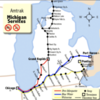In the end it comes down to defining what Amtrak's value is, what the nature of that value is, and then working from there. The idea that Amtrak has value only if a private business could run it at a profit, for example, is problematic, and the airlines give a pretty good example of that. Before they deregulated the airlines in the 1970's, when airfares were price controlled, one of the deals with the devil with that was that in return for flying unprofitable routes to small airports, rural areas, etc, the government in effect guaranteed them a profit and also de facto stopped competition, since you couldn't really compete on price, by fair trading fares. In many ways it was great for the airlines, low population areas still retained access to airline travel (which generally operated at a loss, since if they charged the true cost of serving low volume areas few people could afford it), they made nice profit without having to worry about someone undercutting them, the only people who really lost on the deal were consumers, airfares were very expensive back then. When deregulation happened, to keep airlines flying to low volume areas airlines were granted access to lucrative markets in return for continuing to run those routes, from what I have been told dropping low volume routes is a big deal for an airline.
Deregulation/ 'letting the markets decide' had negative impact as well, in that flying these days is not a pleasant experience, airplanes are designed to crowd as many people as possible into each plane, leg room has disappeared, they routinely overbook flights, the efficient hub and spoke system is prone to delays, and of course they nickel and dime people flying for every last cent, charging things like the emergency row as 'premium', baggage charges, you name it...few people outside those who routinely fly first class are enamored of flying.
Could a private operator make money with Amtrak? Possibly, but there is a parallel to that, the problems with it. Conrail comes to mind, when the railroads that Conrail took over went splat, other train companies weren't exactly battering down the door to take these lines over and not surprisingly, it would have taken a lot of capital to put Conrail in shape after the mess the prior railroads left, and they weren't necessarily in great shape themselves. The government through Conrail spent a lot of money upgrading the railroad, they utilized and developed brand new technology to make shipping more efficient, they replaced track and signal systems, spent a lot of money on it, and by the time it was sold off Conrail was pretty attractive, to the point that two railroads spent a pretty penny buying the sections they wanted. The problem here is that a private operator likely wouldn't want to take on Amtrak for the same reason freight railroads didn't want what became Conrail, and unlike Conrail the government hasn't exactly spent money on Amtrak, not to the level I am talking about, to make it where a private operator would want it.
And like the airline industry, what would be the incentive for Amtrak to keep non profitable routes if a private owner took it over? Let's just assume the NE corridor and some other lines would be profitable (again, hypothetically), why would they keep small town, USA with service? What would be the incentive? And what would the cost of dropping that service be to the areas this happened?
I don't have any ultimate answers, but unless someone can balance out the inherent conflicts with making a profit versus the cost of dropping service, the only option is going to be it stays run by the government purely, or the government subsidizes a private operator to run the network, either through direct price subsidy or through inducements of some sort like they did with the airlines (which also goes to show you people claiming the airlines are 'free market' don't understand how they operate). Again, the fact that Amtrak has survived all the assaults on it, the death by a million pricks, rants by politicians, and even worse, the benign neglect even supposedly pro rail politicians have accorded it often, says a lot about the value of it, perceived or real.






